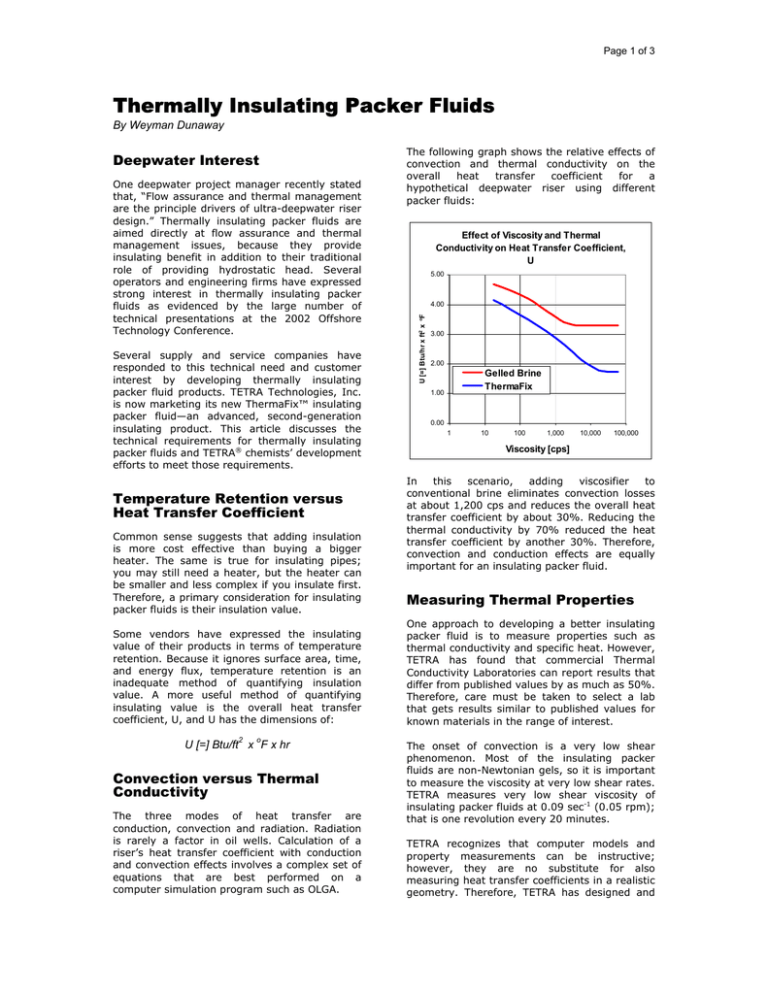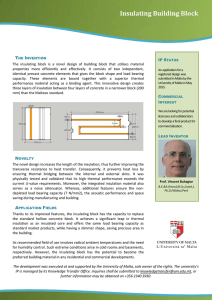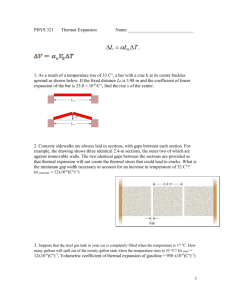
Page 1 of 3
Thermally Insulating Packer Fluids
By Weyman Dunaway
One deepwater project manager recently stated
that, “Flow assurance and thermal management
are the principle drivers of ultra-deepwater riser
design.” Thermally insulating packer fluids are
aimed directly at flow assurance and thermal
management issues, because they provide
insulating benefit in addition to their traditional
role of providing hydrostatic head. Several
operators and engineering firms have expressed
strong interest in thermally insulating packer
fluids as evidenced by the large number of
technical presentations at the 2002 Offshore
Technology Conference.
Several supply and service companies have
responded to this technical need and customer
interest by developing thermally insulating
packer fluid products. TETRA Technologies, Inc.
is now marketing its new ThermaFix™ insulating
packer fluid—an advanced, second-generation
insulating product. This article discusses the
technical requirements for thermally insulating
packer fluids and TETRA® chemists’ development
efforts to meet those requirements.
Temperature Retention versus
Heat Transfer Coefficient
Common sense suggests that adding insulation
is more cost effective than buying a bigger
heater. The same is true for insulating pipes;
you may still need a heater, but the heater can
be smaller and less complex if you insulate first.
Therefore, a primary consideration for insulating
packer fluids is their insulation value.
Some vendors have expressed the insulating
value of their products in terms of temperature
retention. Because it ignores surface area, time,
and energy flux, temperature retention is an
inadequate method of quantifying insulation
value. A more useful method of quantifying
insulating value is the overall heat transfer
coefficient, U, and U has the dimensions of:
U [=] Btu/ft2 x oF x hr
Convection versus Thermal
Conductivity
The three modes of heat transfer are
conduction, convection and radiation. Radiation
is rarely a factor in oil wells. Calculation of a
riser’s heat transfer coefficient with conduction
and convection effects involves a complex set of
equations that are best performed on a
computer simulation program such as OLGA.
The following graph shows the relative effects of
convection and thermal conductivity on the
overall
heat
transfer
coefficient
for
a
hypothetical deepwater riser using different
packer fluids:
Effect of Viscosity and Thermal
Conductivity on Heat Transfer Coefficient,
U
5.00
4.00
U [=] Btu/hr x ft2 x oF
Deepwater Interest
3.00
2.00
Gelled Brine
ThermaFix
1.00
0.00
1
10
100
1,000
10,000
100,000
Viscosity [cps]
In
this
scenario,
adding
viscosifier
to
conventional brine eliminates convection losses
at about 1,200 cps and reduces the overall heat
transfer coefficient by about 30%. Reducing the
thermal conductivity by 70% reduced the heat
transfer coefficient by another 30%. Therefore,
convection and conduction effects are equally
important for an insulating packer fluid.
Measuring Thermal Properties
One approach to developing a better insulating
packer fluid is to measure properties such as
thermal conductivity and specific heat. However,
TETRA has found that commercial Thermal
Conductivity Laboratories can report results that
differ from published values by as much as 50%.
Therefore, care must be taken to select a lab
that gets results similar to published values for
known materials in the range of interest.
The onset of convection is a very low shear
phenomenon. Most of the insulating packer
fluids are non-Newtonian gels, so it is important
to measure the viscosity at very low shear rates.
TETRA measures very low shear viscosity of
insulating packer fluids at 0.09 sec-1 (0.05 rpm);
that is one revolution every 20 minutes.
TETRA recognizes that computer models and
property measurements can be instructive;
however, they are no substitute for also
measuring heat transfer coefficients in a realistic
geometry. Therefore, TETRA has designed and
Page 2 of 3
constructed a 20 foot thermal flow loop to
measure the heat transfer coefficients of packer
fluids in an offshore riser configuration:
heat transfer. Gelling the brine makes the heat
transfer coefficient both lower and more linear.
The Gel + HGMS curve is particularly interesting
because it represents a mixture of gelled brine
and hollow glass microspheres (HGMS). The
HGMS were tested as a means of lowering the
thermal conductivity of the gelled brine. These
results show that HGMS is beneficial at lowering
the heat transfer coefficient. However, HGMS is
thermally inferior to ThermaFix.
Cool Down Time
Another key attribute of insulating packer fluids
is Cool Down Time (CDT)—the time required for
the riser to cool down to the hydrate formation
temperature
after
production
has
been
interrupted. CDTs depend on the composition of
the produced fluid, the riser geometry, and the
thermal characteristics of the packer fluid. So,
OLGA simulations are also used to estimate
CDT. The following plot shows the effect of
viscosity and thermal conductivity on CDT for
the same hypothetical offshore riser used in the
heat transfer coefficient study:
Effect of Viscosity and Thermal
Conductivity on Cool Down Time
TETRA’s Thermal Flow Loop
8.0
7.0
6.0
Cool Down Hours
TETRA’s thermal flow loop consists of a
production string surrounded by a casing string
filled with packer fluid. The riser assembly is
surrounded by a jacket containing chilled water.
Hot fluid is circulated through the production
string. Temperature measurements and flow
rates allow the calculation of the measured heat
transfer coefficient. The following plot shows
typical results from the 20 foot thermal flow
loop:
Gelled Brine
ThermaFix
5.0
4.0
3.0
2.0
1.0
Experimental Heat Transfer Coefficients
for Packer Fluids
0.0
1
10
100
1,000
10,000
100,000
Viscosity [cps]
100.0
U = Btu/hr Ft2 oF
90.0
80.0
Ungelled Brine
70.0
Gelled Brine
60.0
Gel + HGMS
ThermaFix
50.0
Air
40.0
30.0
20.0
10.0
0.0
20.0
70.0
120.0
170.0
220.0
Flow Rate [=] grams/minute
The very non-linear results for ungelled brine
are
characteristic
of
a
material
that
demonstrates both conductive and convective
Gelling the brine increased CDT by about 50%.
Reducing the thermal conductivity by 70% and
viscosifying increased CDT by more than 270%.
Again, being mindful of the need to actually test
CDTs, TETRA has designed and constructed a
cool down tester as shown in the next
photograph:
Page 3 of 3
The time required to cool these fluids from 150oF
to 60oF was:
Experimental Cool Down Times
(150oF to 60oF)
Fluid
Seconds
%
Increase
Computer
Simulation
Brine
Gelled
Brine
ThermaFix
210
397
Basis
89%
Basis
50%
807
280%
270%
These experimental results show remarkably
good agreement with the computer simulated
data.
Conclusions
TETRA’s cool down tester consists of a jacketed
glass column fitted with temperature sensors on
each end. The inside of the column is filled with
hot packing fluid. Then, chilled water is
circulated through the jacket. A computer logs
the temperatures inside the packer fluid and
averages the two RTDs. Typical results are
shown in the following plot:
•
The key attributes for an effective insulating
packer fluid are heat transfer coefficient and
cool down time.
•
Gelling the packer fluid alone has benefits;
but gelling plus lowering the thermal
conductivity provides even greater benefits.
•
ThermaFix exceeds the thermal performance
of gelled brines and gels filled with a proven
insulator such as hollow glass microspheres.
Experimental Cool Down Times of
Packer Fluids
Temperature (F)
180
Brine
160
Gelled Brine
140
ThermaFix
TETRA Technologies, Inc.
120
Corporate Headquarters
25025 Interstate 45 North
The Woodlands, Texas 77380
281.364.2264
100
80
60
40
20
0
0
200
400
600
800
1000
1200
1400
1600
National Sales
713.980.5230
sales@tetratec.com
Time (seconds)
Weyman Dunaway is currently Technology Center Manager of Engineering and Special Projects
for TETRA Technologies, Inc. He graduated BsChE from the Georgia Institute of Technology in
1977.
Copyright © 2003 TETRA Technologies, Inc. All rights reserved.
ThermaFix is a trademark of and TETRA is a registered trademark of TETRA Technologies, Inc.



